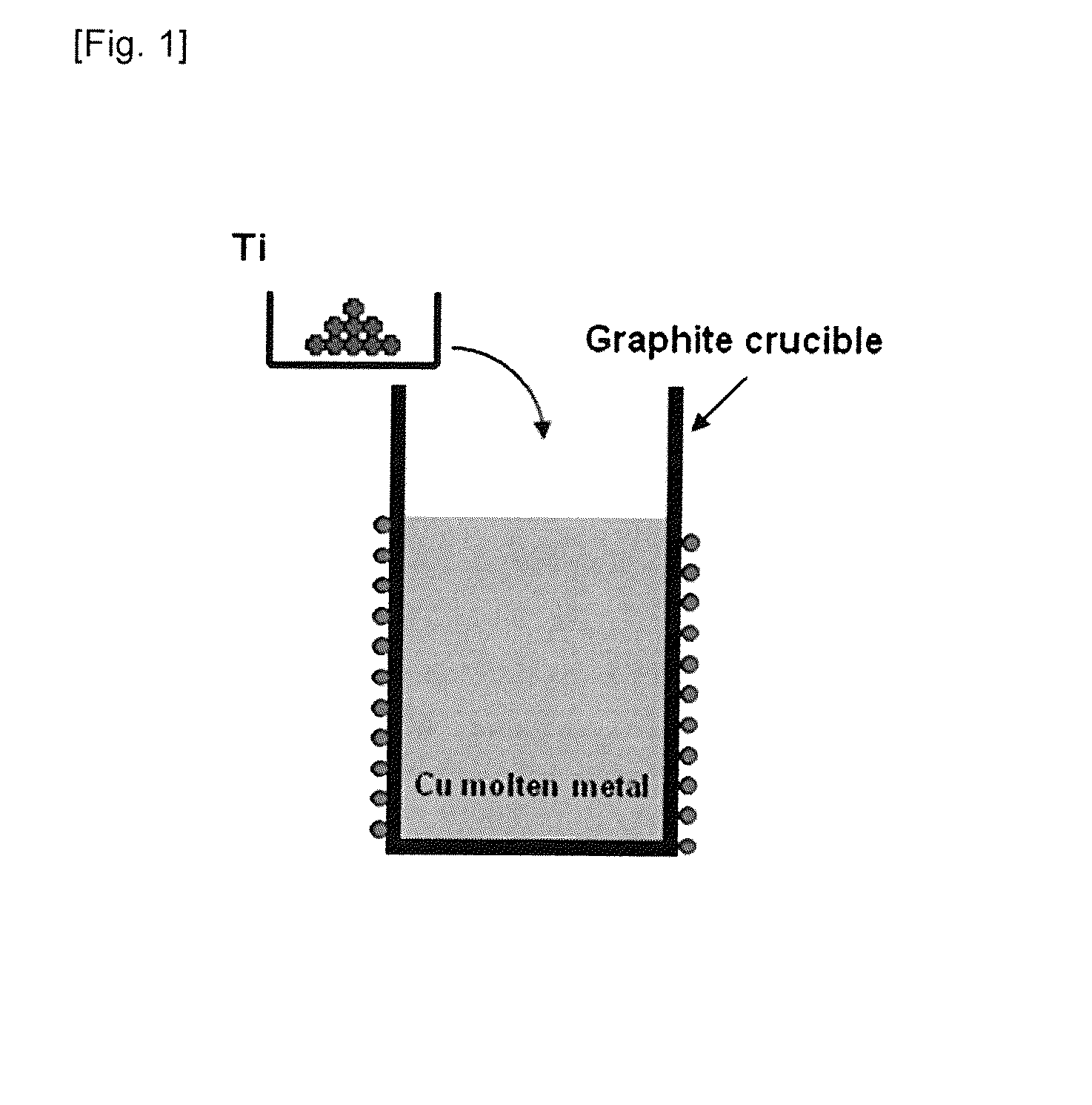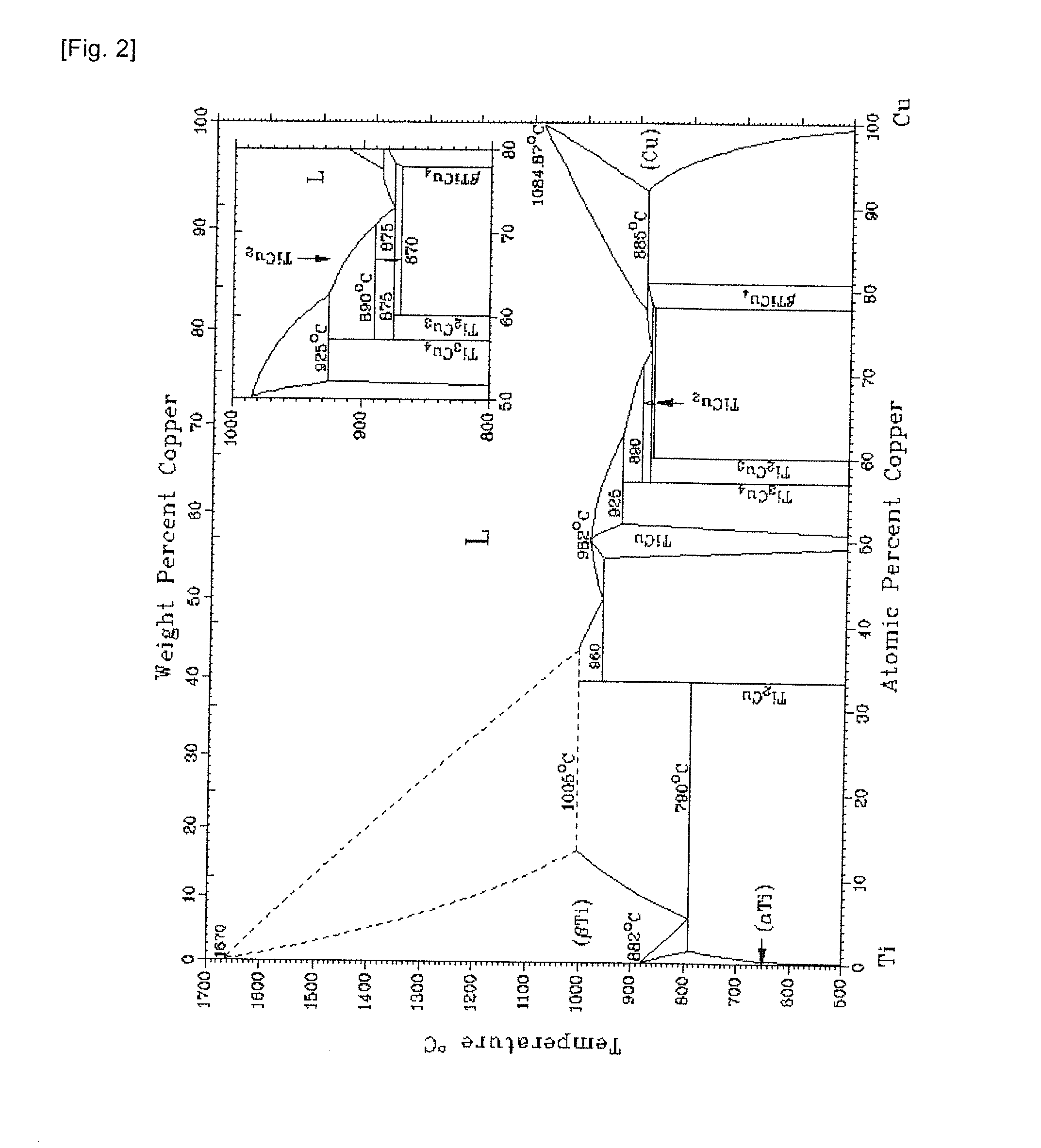Copper-Titanium Alloy Sputtering Target, Semiconductor Wiring Line Formed Using the Sputtering Target, and Semiconductor Element and Device Each Equipped with the Semiconductor Wiring Line
a technology of sputtering target and copper alloy, which is applied in the direction of electrolysis components, vacuum evaporation coatings, coatings, etc., can solve the problems of unavoidable formation of diffusion barrier layers made of ta or tan, copper contamination of semiconductor si substrate, and unsatisfactory means, so as to improve the em resistance, prevent contamination around the wiring line, and improve the effect of corrosion resistan
- Summary
- Abstract
- Description
- Claims
- Application Information
AI Technical Summary
Benefits of technology
Problems solved by technology
Method used
Image
Examples
example 1
[0061]In order to produce a sputtering target comprising 3.0 at % of Ti and a remainder made up of Cu, used as the raw materials were Cu having a purity of 6N and Ti having a purity of 5N.
[0062]Copper was melted via vacuum induction melting. 32187 g of copper was used, and the vacuum degree was set to 0.05 Pa. After melting Cu, the molten metal was retained at 1100 to 1250° C., Ar gas was introduced, and Ti was added. Agitation was performed via natural convection. Time from the addition of Ti to metal tapping was 12 minutes. A copper mold was used, the tapping temperature was set to 1100 to 1250° C., and the molten metal was solidified therein.
[0063]The solidified ingot was subject to forging at 700 to 950° C., and the thickness was thereby reduced from 100 mmt to 70 mmt. This was further subject to hot rolling at 700 to 950° C., and the thickness was further reduced from 70 mmt to 12 mmt. Subsequently, this was subject to heat treatment at 700 to 950° C.×1 hr.
[0064]In addition, th...
example 2
[0070]In order to produce a sputtering target comprising 5.0 at % of Ti and a remainder made up of Cu, used as the raw materials were Cu having a purity of 6N and Ti having a purity of 5N.
[0071]Copper was melted via vacuum induction melting. 32187 g of copper was used, and the vacuum degree was set to 0.05 Pa. After melting Cu, the molten metal was retained at 1100 to 1250° C., Ar gas was introduced, and Ti was added. Agitation was performed via natural convection. Time from the addition of Ti to metal tapping was 12 minutes. A copper mold was used, the tapping temperature was set to 1100 to 1250° C., and the molten metal was solidified therein.
[0072]The solidified ingot was subject to forging at 700 to 950° C., and the thickness was thereby reduced from 100 mmt to 70 mmt. This was further subject to hot rolling at 700 to 950° C., and the thickness was further reduced from 70 mmt to 12 mmt. Subsequently, this was subject to heat treatment at 700 to 950° C.×1 hr.
[0073]In addition, th...
example 3
[0080]In order to produce a sputtering target comprising 7.0 at % of Ti and a remainder made up of Cu, used as the raw materials were Cu having a purity of 6N and Ti having a purity of 5N.
[0081]Copper was melted via vacuum induction melting. 32187 g of copper was used, and the vacuum degree was set to 0.05 Pa. After melting Cu, the molten metal was retained at 1100 to 1250° C., Ar gas was introduced, and Ti was added. Agitation was performed via natural convection. Time from the addition of Ti to metal tapping was 12 minutes. A copper mold was used, the tapping temperature was set to 1100 to 1250° C., and the molten metal was solidified therein.
[0082]The solidified ingot was subject to forging at 700 to 950° C., and the thickness was thereby reduced from 100 mmt to 70 mmt. This was further subject to hot rolling at 700 to 950° C., and the thickness was further reduced from 70 mmt to 12 mmt. Subsequently, this was subject to heat treatment at 700 to 950° C.×1 hr. In addition, this wa...
PUM
| Property | Measurement | Unit |
|---|---|---|
| Grain size | aaaaa | aaaaa |
Abstract
Description
Claims
Application Information
 Login to View More
Login to View More - R&D
- Intellectual Property
- Life Sciences
- Materials
- Tech Scout
- Unparalleled Data Quality
- Higher Quality Content
- 60% Fewer Hallucinations
Browse by: Latest US Patents, China's latest patents, Technical Efficacy Thesaurus, Application Domain, Technology Topic, Popular Technical Reports.
© 2025 PatSnap. All rights reserved.Legal|Privacy policy|Modern Slavery Act Transparency Statement|Sitemap|About US| Contact US: help@patsnap.com



